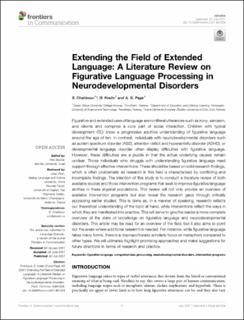| dc.contributor.author | Chahboun, Sobh | |
| dc.contributor.author | Kvello, Øyvid | |
| dc.contributor.author | Page, Alexander Gamst | |
| dc.coverage.spatial | Norway | en_US |
| dc.date.accessioned | 2021-11-18T12:16:17Z | |
| dc.date.available | 2021-11-18T12:16:17Z | |
| dc.date.issued | 2021 | |
| dc.identifier.citation | Frontiers in Communication. 2021, 6, 1-14. | en_US |
| dc.identifier.issn | 2297-900X | |
| dc.identifier.uri | https://hdl.handle.net/11250/2830287 | |
| dc.description.abstract | Figurative and extended uses of language are nonliteral utterances such as irony, sarcasm, and idioms and comprise a core part of social interaction. Children with typical development (TD) show a progressive adultlike understanding of figurative language around the age of ten. In contrast, individuals with neurodevelopmental disorders such as autism spectrum disorder (ASD), attention deficit and hyperactivity disorder (ADHD), or developmental language disorder often display difficulties with figurative language. However, these difficulties are a puzzle in that the actual underlying causes remain unclear. Those individuals who struggle with understanding figurative language need support through effective interventions. These should be based on solid research findings, which is often problematic as research in this field is characterized by conflicting and incomplete findings. The intention of this study is to conduct a literature review of both available studies and those intervention programs that seek to improve figurative language abilities in these atypical populations. This review will not only provide an overview of available intervention programs but also reveal the research gaps through critically appraising earlier studies. This is done as, in a manner of speaking, research reflects our theoretical understanding of the topic at hand, while interventions reflect the ways in which they are manifested into practice. This will serve to give the reader a more complete overview of the state of knowledge on figurative language and neurodevelopmental disorders. This article may be read for an overview of the field, but it also aims to point out the areas where additional research is needed. For instance, while figurative language takes many forms, there is a disproportionate scholarly focus on metaphors compared to other types. We will ultimately highlight promising approaches and make suggestions for future directions in terms of research and practice. | en_US |
| dc.language.iso | eng | en_US |
| dc.publisher | Frontiers in Communication | en_US |
| dc.rights | Navngivelse 4.0 Internasjonal | * |
| dc.rights.uri | http://creativecommons.org/licenses/by/4.0/deed.no | * |
| dc.subject | Figurative language | en_US |
| dc.subject | comprehension | en_US |
| dc.subject | processing | en_US |
| dc.subject | neurodevelopmental disorders | en_US |
| dc.subject | intervention programs | en_US |
| dc.title | Extending the Field of Extended Language: A Literature Review on Figurative Language Processing in Neurodevelopmental Disorders | en_US |
| dc.type | Journal article | en_US |
| dc.description.version | publishedVersion | en_US |
| dc.rights.holder | ©2021 S. Chabhoun; Ø.Kvello; A.G. Page | en_US |
| dc.source.pagenumber | 14. | en_US |
| dc.source.volume | 6 | en_US |
| dc.source.journal | Frontiers in Communication | en_US |
| dc.identifier.doi | 10.3389/fcomm.2021.661528/full | |
| dc.identifier.cristin | 1923649 | |

